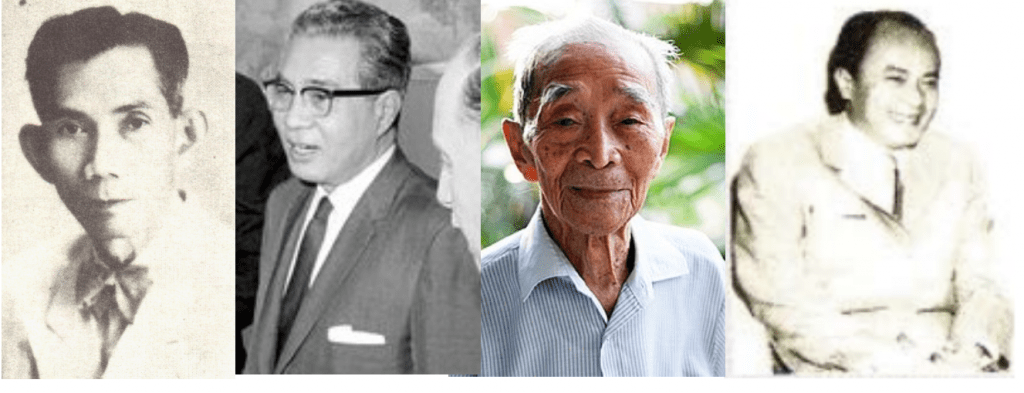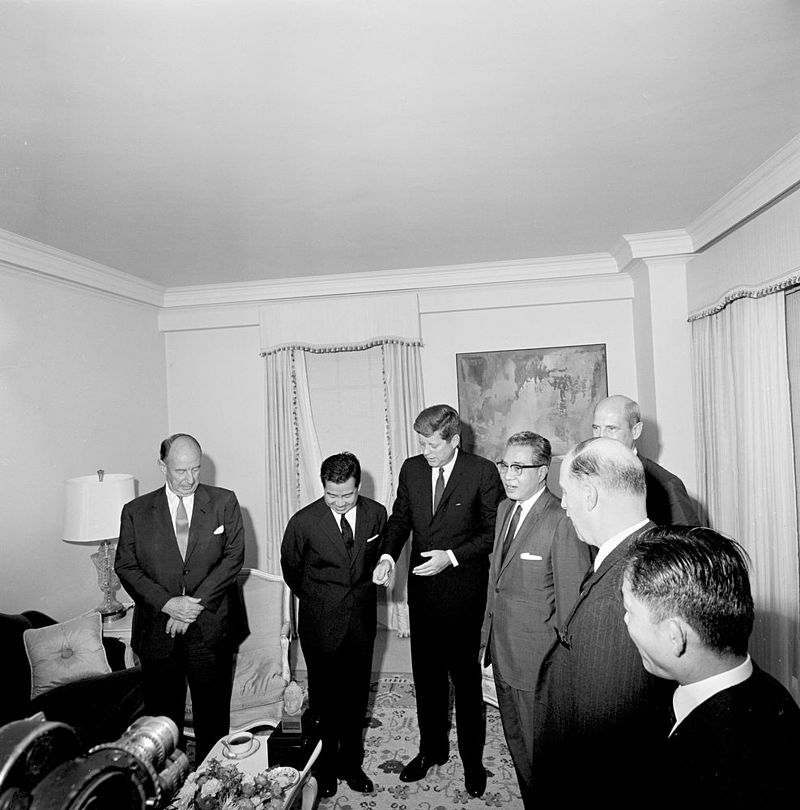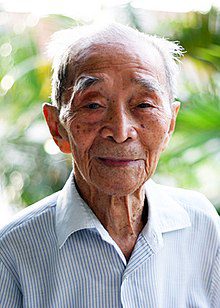
*Continuing from PART I , PART II and PART III
Pho Proeung
18 Apr 1960 – 28 Jan 1961: 286 days

Born August 12, 1903 to an aristocratic family in Phnom Penh, Pho Proeung was educated at Lycee Sisowath. He worked in Kampot from 1930-35 at the Inspectorate of Political and Administrative Affairs
After being made Deputy Governor of Kandal in 1939, in October 1940, he was appointed Chauvaykhet (governor) of Pursat, Prey Veng in 1941 and later Kampot and Kampong Cham.
A Sihanouk loyalist, with the rank of Oudom-Montrey (high mandarin), he was Secretary of State for National Defense in Yen Sambaur’s government.
(September 29, 1949 – May 2, 1950), and appointed shortly after as a member of the Military Commission for the application of the Franco-Khmer treaty.
On February 2, 1951, he was appointed governor of Battambang, where he stayed for little over a year.
In 1954, he was made Private Adviser to the King and Minister of National Education and Fine Arts in the in two cabinets chaired by Penn Nouth (August 1 – August 26, 1954/August 27, 1954 – January 25, 1955)
-Minister of Interior and Surface Defense in the 25th Government of Cambodia under Leng Ngeth (January 26 – September 20, 1955). US State Department records have Pho Proeung as Minister of Finance in early 1955.
Under the Sangkum he was made Director of the Royal School of Administration in 1956 and 1957.
Minister of National Education and Minister of Labor and Social Action in the 10th Sangkum Cabinet of Penn Nouth (January 22 – 29 April 1958).
-Elected deputy for the constituency of Koki (Kandal) in the 1958 elections.
-Minister of Labor and Social Action and Minister of Worship in the 11th Sangkum office under Sim Var (April 30 – July 10, 1958).
-Minister of the Interior, Worship and Relations with the Parliament in the 12th Sangkum cabinet of Sihanouk (July 11, 1958 – February 17, 1959).
Pho Proeung as Prime Minister welcomed a state visit of Chinese Premier Chou En-Lai, and the pair released a joint declaration on May 8, 1960, promising peace and continued relations between the countries.
His cabinet collapsed in January 1961, after a corruption scandal. He was replaced by Penn Nouth, who chaired his 5th cabinet (January 28- November 21, 1961) and then Sihanouk’s 10th time in office (November 17, 1961-August 6, 1962).
Pho Proeung married twice and had 9 children. He died in 1975.
Nhiek Tioulong
13 Feb 1962 – 6 Aug 1962

Nhiek Tioulong was born on August 23, 1908 near the palace in Phnom Penh into a lineage of royal mandarins with Chinese ancestry. After primary studies at Lycee Sisowath College in Phnom Penh, he studied at the prestigious Chasseloup Laubat High School in Saigon where he received a baccalaureate in philosophy.
He became involved in politics in 1932, and rose through the ranks, becoming governor of the province of Pursat in 1937, and Kampong Cham from 1939 to 1944,
On March 9, 1945, thanks to the Japanese coup against the French, he was appointed governor Phnom Penh.
From August 14 to October 16, 1945, he was Minister of National Education in the cabinet headed by Son Ngoc Thanh.
When the French returned, he was made Minister of Finance under Sisowath Monireth. He accompanied King Norodom Sihanouk to France, from April to June 1946.
On December 7, 1946, he was put in charge of supervising the departure of the Thais from the north west around Battambang, which they had occupied for five years during the war.
In 1947, he created the “Kanapac Khemara Vothanaka” (parti de la Rénovation Khmère/Khmer Renovation Party) a right-wing party, which participated in legislative elections the same year, but won no seats.
In April 1948, he became delegate of the Cambodian government to the French High Commissioner in Indochina, then, in August of the same year, Cambodian delegate to the High Council of the French Union in Paris. In September, he was part of the French delegation to the UN, as an advisor.
On November 22, 1949, Nhiek Tioulong was briefly appointed a colonel of the Khmer Royal Army and Chief of Staff, but at the end of December 1949, he returned to his post with the French High Commissioner, then become delegate of the Cambodia to the Franco-Khmer Agreements Application Commission.
In May 1950, he was appointed governor of Battambang with the rank of minister.
On January 1, 1951, he returned to government as Minister of Finance, a post he held until May 14, 1951, when he became Minister of State for Information.
In the 1951 elections, the Khmer Renovation Party, reinforced by Lon Nol, won 2 seats.
In June 1953, when Norodom Sihanouk went into exile in his bid for independence, Tioulong Nhiek headed the Royal Information Service, based in Battambang.
At the end of December 1953, with independence gained, he was reappointed governor of Phnom Penh and took part in negotiations with the French concerning the transfer of powers between the colonial administration and the new Cambodian government.
On April 7, 1954, he was appointed Minister of State for Foreign Affairs
And became the first general of the Royal Khmer Army (the second would be Lon Nol, in 1955) and was be Cambodia’s military representative to the Geneva Accords.
In 1955, he began a career as an ambassador, first in Japan, then in 1957 the USSR, Poland and finally Czechoslovakia. In 1958 he returned to Cambodia and joined several governments as a minister:
– January 22 to April 29, 1958: Minister of State in charge of the Interior, National Security and Information.
-April 30 to July 10, 1958: Vice-President of the Council, Minister of Planning, Production, Economic Affairs, Public Works, Telecommunications and Tourism.
-February 18 to June 13, 1959: Vice-President of the Council (with Son Sann), Minister of the Interior, Justice, Information, Planning and General Sanitation.
– June 14, 1959 to April 19, 1960: Vice-President of the Council, Minister of National Education, Planning and Tourism.
– April 20, 1960 to January 28, 1961: first Vice-President of the Council, Minister of Planning, Tourism, Production, Public Works and Telecommunications.
-January 29, 1961 to February 12, 1962: Minister of State in charge of foreign affairs and tourism.
– February 13 to August 6, 1962: Chairman of the Council (Prime Minister- acting for Sihanouk).

In October 1962, he was appointed governor of Kirirom, and on November 6, 1962, became inspector of the Royal Khmer Armed Forces and vice-president of the High Council of the Throne.
In 1965 or 1966, he starred as the lead role in Sihanouk’s first feature-length film ‘Apsara’.
In October 1966, he briefly replaced Lon Nol as the head of the army, and in 1969, retired to France where he led a quiet life until the mid-1980s when he became vice-president of the National United Front for an Independent, Neutral, Peaceful and Cooperative Cambodia (FUNCINPEC). He led the movement from 1989 to 1992.
On October 26, 1993, he was appointed private adviser to the king.
Nhiek Tioulong married Measketh Samphotre and the couple had 7 daughters- the most well known being Tioulong Saumura- a member of the Cambodia National Rescue Party who was elected to represent Phnom Penh in the National Assembly of Cambodia in 2003, and also the Deputy Governor of Cambodia’s Central Bank from 1993 to 1995. She is the wife of Sam Rainsy.
Nhiek Tioulong died in a Hong Kong hospital on June 9, 1996.
Chau Sen Cocsal Chhum
6 Aug 1962 – 6 Oct 1962: 62 days

Although only an interim leader, lasting just 62 days in ’62, Chau Sen Cocsal Chhum has gone into history as the longest living former statesman, his only potential rival was 6-day Prime Minister Ek Yi Oun (1910–2013), whose birthdate was not recorded. Before he died, aged 103, he apologized for the disruption his funeral may cause in Phnom Penh.
Chhum was born into a Khmer Krom family what is now An Giang Province, Vietnam, on 1 September 1905. Chuum attended primary school at Phnom Penh before moving to Saigon where he attended the Lycée Chasseloup Laubac. At the age of 21, Chhum became the first Cambodian to graduate there, with a baccalaureate in French and Philosophy. Upon graduation, he began a career in the French Colonial Administration in Phnom Penh.
In 1928, Chau Sen Cocsal was promoted Deputy Governor of Takéo Province (Gouverneur Adjoint), then successively posted in Tralach District, Takéo Province, in 1931 and Thbaung Khmaum, Kompong Cham Province, in 1935. In 1938, Chhum became Governor of Svay Rieng Province. From 1940 to 1944, he was Governor of Kompong Chhnang Province. During World War II, Chhum refused to supply forced labour to the Japanese occupying forces in Cambodia and joined resistance in the jungle.
With the return of the French Administration, Chhum was nominated Mayor of Phnom Penh in 1945, Governor of Kompong Cham Province in 1946, then Governor of Kandal Province in 1948. In 1951, Chhum was sent to Thailand, as Cambodia’s first ambassador to a foreign country. Chhum returned to Cambodia in 1952 and once more took to the jungle to fight for the country’s independence from France.
In 1955, Chau Sen Cocsal was elected to the Cambodian National Assembly as deputy of Kompong Cham Province. From 1958 to 1963, he occupied the position of President of the National Assembly. In 1969, at the age of 64, Chhum retired from public office.
In April 1975, after the fall of Phnom Penh to the Khmer Rouge and Saigon to North Vietnamese troops and the Viet Cong, as Chau Sen Cocsal was visiting relatives in Kampuchea Krom, he was arrested by Vietnamese authorities. Charged with spying for the US Central Intelligence Agency, Chhum was incarcerated for 17 months in what he would later describe as a “chicken box” then in a room where he took turns sleeping with 40 other prisoners. Chau Sen Cocsal spent an additional two years under house arrest in Saigon. Under the pressure of France, Vietnam released Chhum, who was allowed to migrate to France with his wife.
In 1991, following the signature of the Paris Peace Agreements, King Norodom Sihanouk nominated Chau Sen Cocsal Chhum as President of Cambodia’s Supreme National Council (SNC). From 1992 onwards, he became High Privy Advisor of King Norodom Sihanouk. In 1993, Chau Sen Cocsal Chhum was awarded the highest rank in Cambodia’s civil service, “Samdech”. The same year, he became Dean of the Constitutional Council. Chhum retired a second time from public office in 2007. His decorations include Grand Croix de l’Ordre Royal (Cambodia) and Commandeur de la Légion d’honneur (France).
On 22 January 2009, at the age of 103, Cambodia’s last remaining civil servant from the French Administration, and the Sangkum Reastr Niyum, died peacefully, surrounded by his family. Chau Sen Cocsal Chhum was publicly cremated with full military guard and honour. He was saluted by official communiqués by King Father Norodom Sihanouk, King Norodom Sihamoni, France’s Ministry of Foreign Affairs, and the Khmer Krom community.
A few years before his death, Chhum had already asked his grandson to convey his apologies to the population of Phnom Penh for the traffic congestion that his long funeral cortege would cause.
On 2 April 1940, Chau Sen Cocsal married Vann Thi Hai and they had seven children. (Wikipedia)
Prince Norodom Kanthol
6 Oct 1962 – 22 Oct 1966: 1478 days

Born September 15, 1920 in Phnom Penh, the Prince Norodom Kanthol was the eldest of children of HRH Norodom Singha and Princess Sisowath Thavet Roeungsi.
After studying in Phnom Penh and Saĩgon, he was entered the public administration by becoming vice-governor of Phnom Penh in 1944. From 1947 to 1952, he studied in France where he obtained a diploma in agricultural engineering from the University of Nancy. Upon returning to Cambodia, he was appointed 1st Secretary at the Cambodian Embassy in Washington. He was then promoted to Minister Plenipotentiary at the Cambodian Embassy in Japan. He was also a member of the High Council of the Kingdom.
From 6 October 1962 to 25 October 1966: he was appointed Prime Minister (President of the Council) with an accumulation of portfolios, sometimes of Minister of the Interior, sometimes of Minister of Foreign Affairs. His time in office- over 4 years- was the longest consecutive term of any previous Prime Minister- most previous governments had collapsed after less than a year.
Between October 6, 1962 to October 25, 1966, Norodom Kantol formed three governments:
• October 6, 1962, his first government (19th government of the Sangkum)
• December 25, 1964, his second government (20th government Sangkum)
• May 7, 1965, his third government (21st Sangkum government)
In 1963, as Prime Minister he represented the Kingdom of Cambodia at the funeral of President Kennedy.
In April 1966, in his capacity as Minister for Foreign Affairs, he sent a letter to the United Nations Security Council to protest against the occupation of Preah Vihear temple by Thai soldiers.
Other notable events during his four years in office included:
• High school riots in Siem Reap
• Saloth Sâr (Pol Pot) becoming secretary general of the future Communist Party of Kampuchea
• Beginning of anti-Sihanoukist broadcasts on the Khmer Serei radio station based in South Vietnam and Thailand
• Economic reforms and rejection of American aid
• Assassination of Ngo Dinh Diem and Kennedy; death of Sarit Thanarat
• Death sentence and execution of Khmer Serei leader and dissident Preap In
• Occupation of the Preah Vihear temple by the Thai army
• A state visit by Charles de Gaul to Phnom Penh
• Repeated violations of Cambodian space and territories by the South Vietnamese armies- bombardments and gunfire used to destroy villages
• Demonstrations organized by the authorities against the American and British embassies
• Creation of four new universities: the Royal Technical University, the Royal University of Fine Arts, the Royal University of Kampong Cham and Takeo-Kampot
• Repeated failures of negotiations with North Vietnam and the Vietcong on borders and territory
• Border disputes on both Thai and Vietnamese sides
• Breakdown of diplomatic relations with the USA.
• Secret Cambodian-Chinese military treaty to facilitate the passage of Vietnamese Communists and Chinese material across Khmer territory (the Ho Chi Minh Trail and Sihanouk Trail)
• The US government accused Cambodia of granting sanctuaries to the Vietcong. US military authorities receive clearance to attack inside Cambodian territory.
In April 1975, he was deported by the Khmer Rouge to Phoum Thmey, Khum Prek Meas, Srok Lovea Em, Prey Veng province (according to the testimony of another prisoner). He was probably executed in 1976.
He was married to Chuop Samon and had 8 children.
The term ‘Prime Minister’ is used loosely to refer to the parliamentary Head of State- as other terms are used in Cambodian political history.
There are major gaps in some of the profiles- which are taken from French and English language sources. Some of the dates and days in office may not be totally correct. The names and dates in office are taken from WORLDSTATESMAN and may not always tally with other sources.
Multiple sources including KBN, KI MEDIA, WIKIPEDIA and Sakou Samoth- HOMMES ET HISTOIRE DU CAMBODGE

One thought on “Cambodian Prime Ministers IV- 1960-66”